BDD (Behavior-Driven Development) testing is a software testing methodology that focuses on testing based on business requirements. The goal of BDD testing is to align the testing process with the business requirements so the development team can deliver software that meets the business’s needs.
This methodology can help improve communication and collaboration between the development team and the business stakeholders. It also helps improve the software’s quality by ensuring that the business requirements are met.
There are many tools available on the market to implement BDD testing. In this article, we will discuss the top 5 BDD testing tools.
BDD Testing Tools
testRigor
testRigor is a cloud-based testing software that supports BDD and SDD (Specification-Driven Development). It uses AI and ML to allow users to create and execute test scenarios without writing any code.
Example of simple English-based test creation through testRigor.
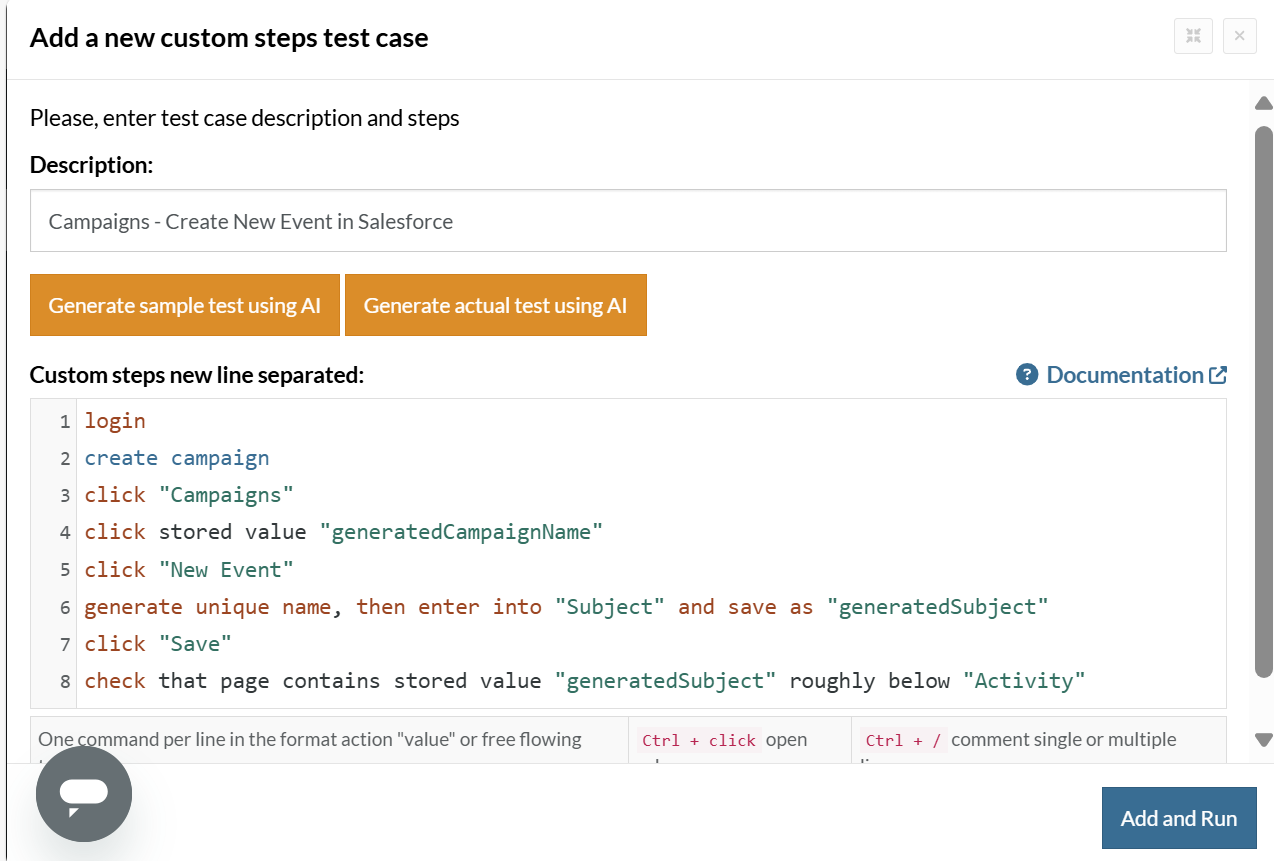
Features of testRigor
- testRigor uses simple English-like commands to write test scenarios. This makes it easy for non-technical team members to participate in the testing process.
- Unlike other tools, testRigor tests do not need step definitions or feature files, which means the process is much faster and more efficient. You just write English statements and let testRigor’s AI engine do the rest.
- Test across different platforms (web, mobile, and desktop) and multiple browsers and OSs.
- testRigor provides integration with various testing frameworks like Jira, TestRail, Zephyr, XRay, Gitlab, PagerDuty and many others.
- The tool provides a user-friendly dashboard that displays the detailed results of the test scenarios.
- If you need to write reusable steps (subroutines), you can do that in plain English as well.
- You can run tests in parallel using this tool.
- The interface is easy to use and slashes the learning curve to a bare minimum.
- Since testRigor uses AI, it reduces the chances of flakey tests through smart self-healing mechanisms.
You can read more about testRigor over here – testRigor Reviews [2024] – Pros, Cons, Features and Pricing
Considerations in testRigor
- The main limitation of testRigor is it’s a paid tool, which means it won’t work for companies that only choose open-source software. However, you can use a public free account, if you can keep your tests in public domain.
- If your team is only used to programming, then it might take them some time to adjust to writing plain English for test cases.
Cucumber
Cucumber is one of the most popular BDD testing tools available. It keeps business requirements or specifications at the forefront. Quite often, Cucumber scenarios serve as executable specifications. That is, they not only describe the system’s behavior but also act as test cases that can be run to verify it.
Example of a feature file in Cucumber.
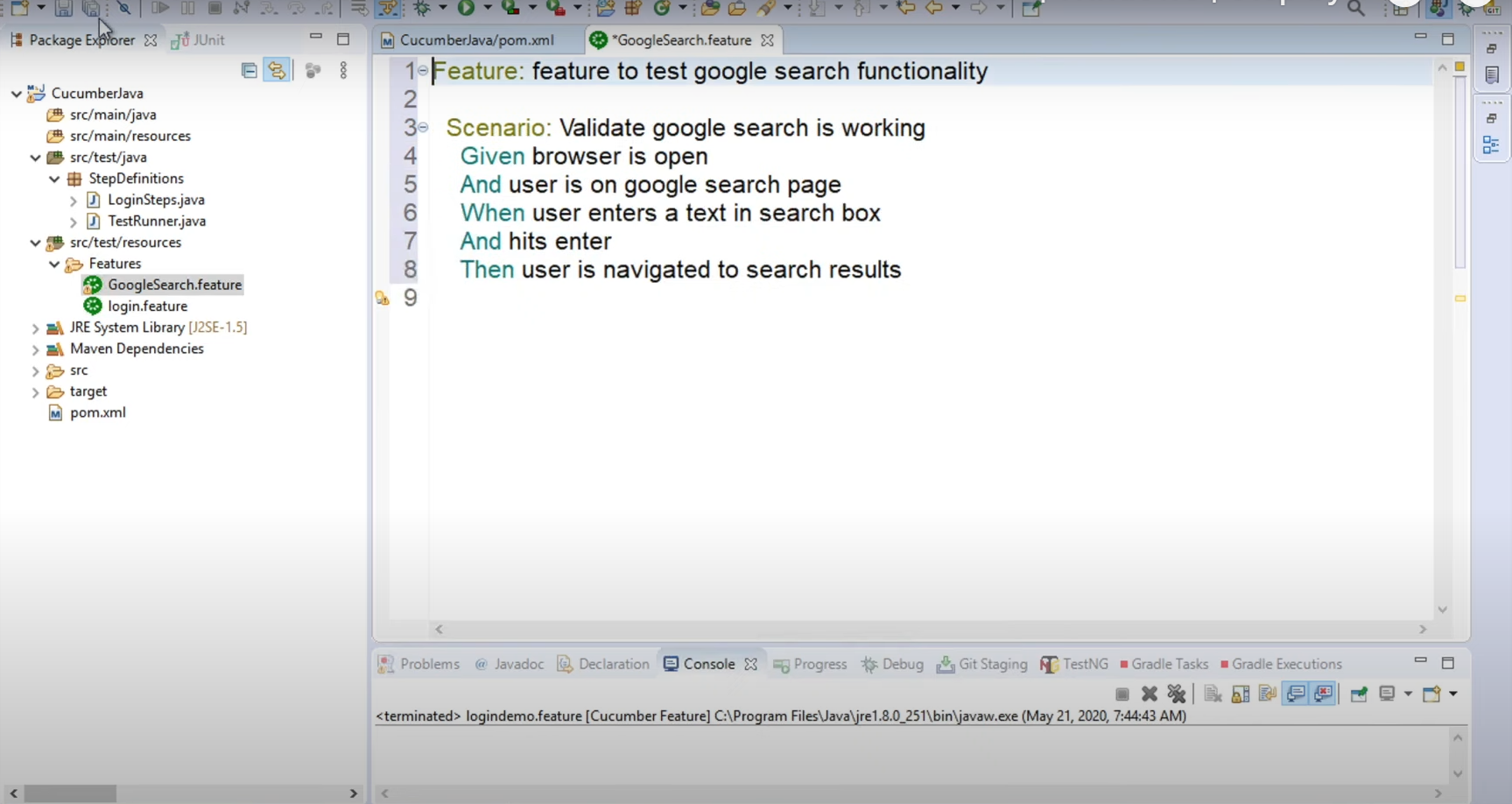
Example of Cucumber step definition in Java.
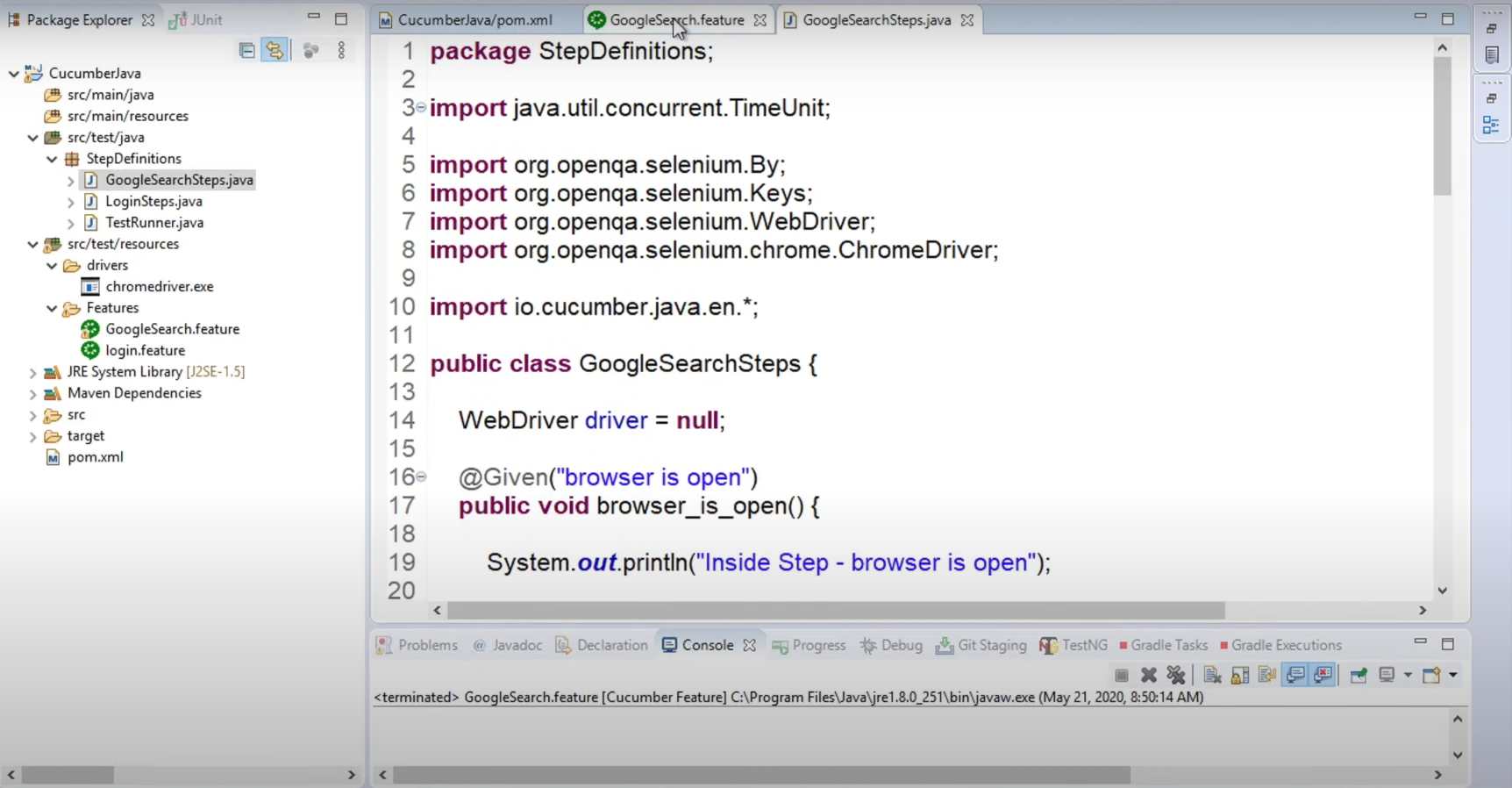
Features of Cucumber
- Cucumber uses a plain-text language called Gherkin that allows the definition of test scenarios using simple language constructs like “Given,” “When,” “Then,” “And,” and “But.”
- It supports multiple programming languages such as Java, Ruby, Python, and others.
- Cucumber can be easily extended and integrated with various frameworks, tools and plugins. It also supports integration with testing frameworks like JUnit, TestNG, and various mocking tools.
- You can use Cucumber to test on different environments and multiple platforms including web, mobile, and even API testing.
- You can write reusable code for Gherkin steps which makes it easy to maintain and scale test cases.
- It supports running tests in parallel which can significantly reduce the time required for test execution, especially in large projects.
- Cucumber has comprehensive documentation and a large, active community that continuously contributes to the development of the tool.
- It easily integrates with Continuous Integration/Continuous Deployment (CI/CD) pipelines.
- Cucumber is an open-source tool.
You can read more about how to build a Cucumber framework over here – Cucumber JS with Selenium: BDD framework in QA.
Considerations in Cucumber
- For teams new to BDD or Cucumber, there is a learning curve associated with understanding how to write effective scenarios and step definitions.
- Although Gherkin syntax is designed to be readable by non-technical users, writing effective and maintainable Gherkin scenarios often requires a deep understanding of both the domain and the technical implementation. Non-technical stakeholders may struggle to write or understand scenarios without significant guidance. This defeats the purpose of using Cucumber to bridge communication gaps.
- Writing Gherkin scenarios and step definitions requires additional effort compared to traditional testing frameworks. Maintaining and updating Gherkin files can become cumbersome as the number of scenarios grows. Especially if the underlying application changes frequently.
- The tool might be slower when executing a large number of test scenarios compared to other testing tools.
- Despite the ease of the Gherkin language, there’s a dependency on step definitions that require coding. Thus, you still need to someone to translate what the step does to non-technical stakeholders.
SpecFlow
SpecFlow is another popular BDD testing tool. It is a .NET-based open-source tool that uses the Gherkin syntax to write test scenarios. SpecFlow also provides integration with Visual Studio.
Example of a feature file in SpecFlow.

Example of step definitions in SpecFlow.

Features of SpecFlow
- Uses the Gherkin syntax to provide easy BDD testing.
- SpecFlow is fully integrated with the .NET ecosystem, making it easy to use with .NET Core, .NET Framework, and .NET 5/6 applications.
- It supports writing step definitions in C#, VB.NET or F#.
- It provides full integration with Visual Studio and includes features like syntax highlighting, IntelliSense and debugging for Gherkin files.
- SpecFlow supports data-driven testing through Scenario Outline with Examples tables. This helps execute the same scenario multiple times with different inputs.
- Like Cucumber, SpecFlow supports parallel test execution to speed up test runs. This is very useful in CI/CD environments.
- You can generate detailed reports on test execution, including pass/fail results and get insights into the coverage of specifications. SpecFlow can generate these reports in formats like HTML, JSON and XML. You can further integrate with third-party reporting tools like SpecFlow+ LivingDoc for enhanced reporting capabilities.
- Supports cross-platform and cross-browser testing.
- SpecFlow is an open-source framework.
You can learn more about SpecFlow over here – What is SpecFlow?
Considerations in SpecFlow
- Teams new to BDD or SpecFlow may face a steep learning curve. This learning curve can be in terms of programming in .NET or Gherkin syntax.
- Although Gherkin syntax is designed to be readable by non-technical users, writing effective and maintainable Gherkin scenarios often require a deep understanding of both the domain and the technical implementation. Non-technical stakeholders may struggle to write or understand scenarios without significant guidance. This defeats the purpose of using SpecFlow to bridge communication gaps.
- There’s a dependency on programmers to write step definitions. Gherkin alone is not enough.
- SpecFlow is heavily integrated with the .NET ecosystem which makes it less suitable for teams that are working in mixed or non-.NET environments. If your project involves technologies outside of .NET, you might face integration challenges.
Behave
Behave is a Python-based open-source BDD testing tool. It uses the Gherkin syntax to write test scenarios. In addition, behave provides integration with various testing frameworks like Pytest, Robot Framework, and others.
Example of feature file and step definitions in Behave.
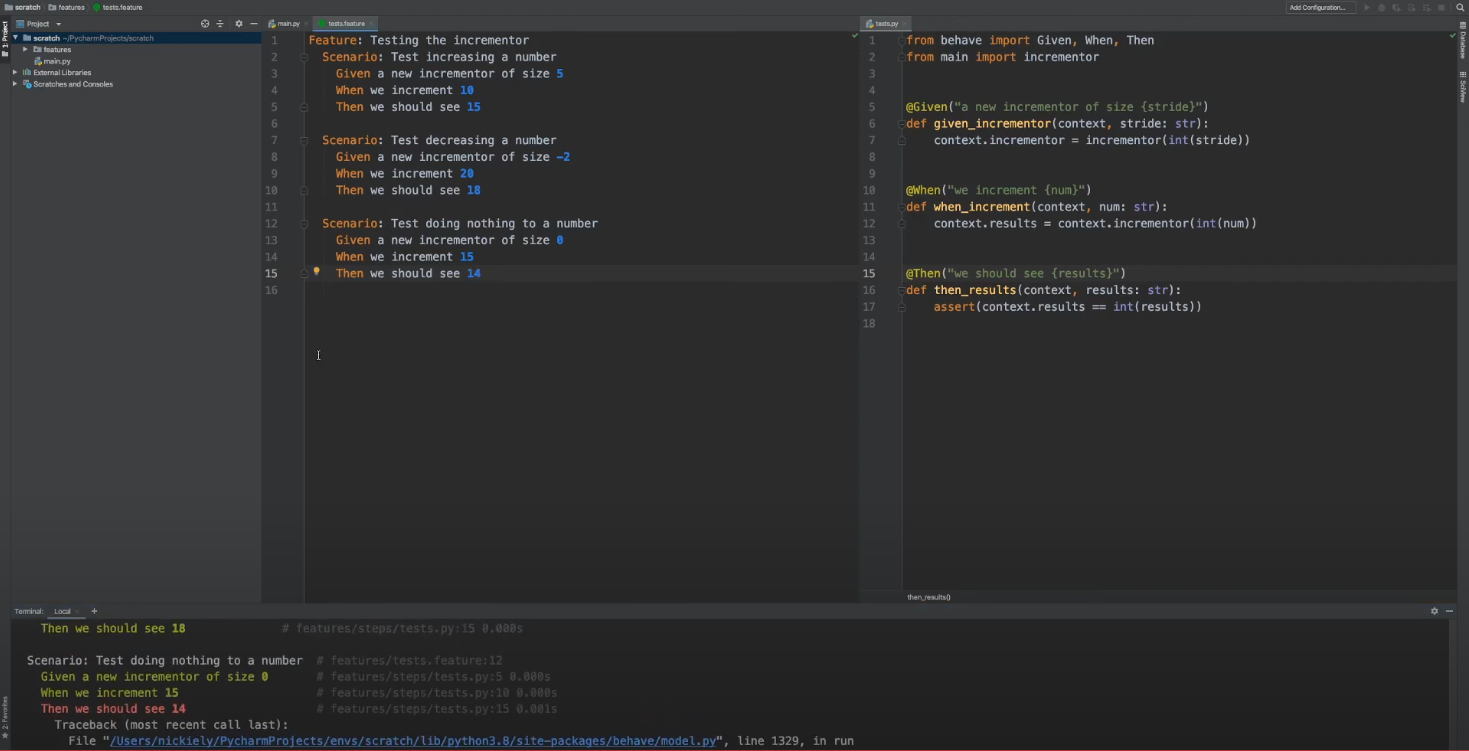
Features of Behave
- It uses the Gherkin syntax to provide easy BDD testing.
- Behave is fully integrated with Python.
- It supports data-driven testing through Scenario Outline with Examples tables. This helps execute the same scenario multiple times with different inputs.
- This tool supports parallel test execution and CI/CD integrations to speed up test runs.
- You can use this tool alongside mocking frameworks such as unittest.mock or third-party libraries like pytest-mock to create isolated test scenarios.
- Behave is not limited to UI testing and can be used for testing behavior across different layers of the application, including backend services, APIs, and databases.
- Behave has a supportive community and extensive documentation, including tutorials, examples, and guides.
- You can generate detailed test execution reports, including information on passed, failed, and skipped scenarios.
- Behave is open source.
You can read more about Behave over here – Behave Overview, Advantages, and Disadvantages [2024]
Considerations in Behave
- Teams new to BDD or Behave may face a steep learning curve. This learning curve can be in terms of programming in Python or Gherkin syntax.
- Although Gherkin syntax is designed to be readable by non-technical users, writing effective and maintainable Gherkin scenarios often require a deep understanding of both the domain and the technical implementation. Non-technical stakeholders may struggle to write or understand scenarios without significant guidance. This defeats the purpose of using Behave to bridge communication gaps.
- There’s a dependency on programmers to write step definitions. Gherkin alone is not enough.
- Behave is inherently tied to Python. If your project is not using Python, or if your team lacks Python expertise, this could be a limitation.
Gauge
Gauge is an open-source BDD testing tool. It uses a plain-text specification language called Markdown to write test scenarios. The main focus of Gauge is to ensure easy and collaborative acceptance testing.
Example of BDD style specifications in Gauge using Markdown.
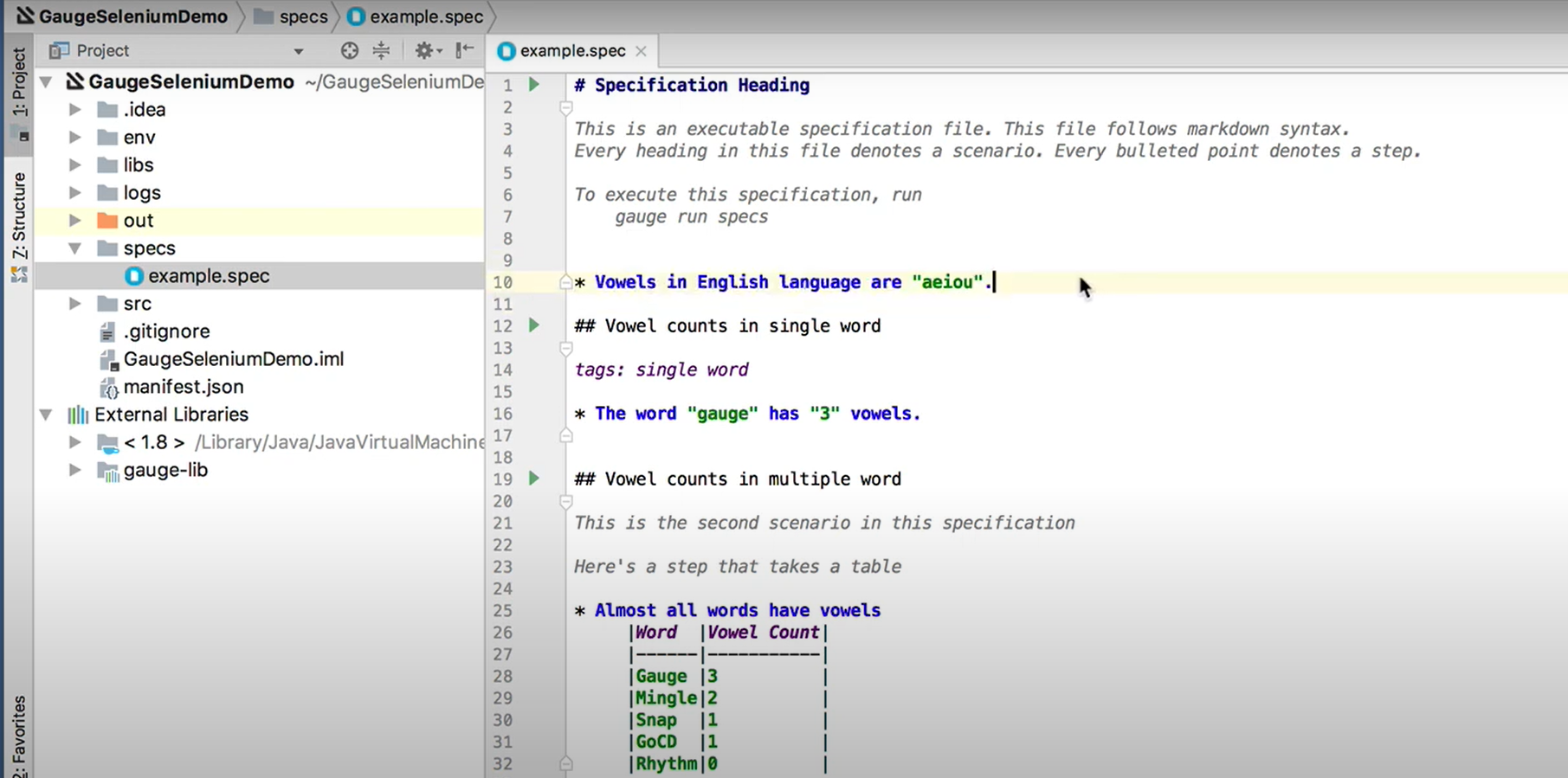
Example of step implementation of specifications using Java.
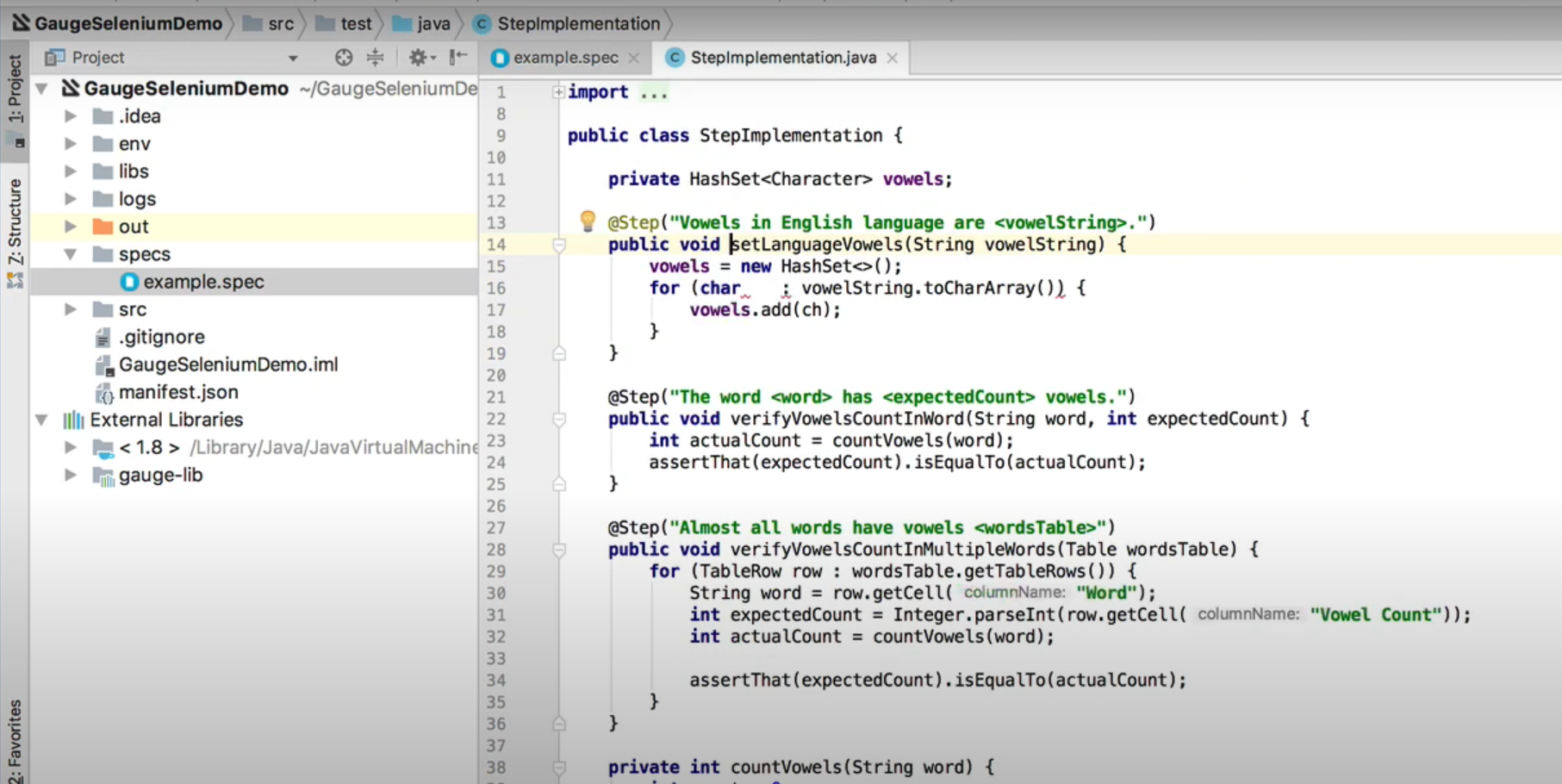
Features of Gauge
- Gauge allows test specifications to be written in Markdown, a simple and widely-used markup language. The use of Markdown eliminates the need for complex Gherkin syntax which is more natural and flexible for writing test cases.
- Gauge supports multiple programming languages for writing step implementations, including Java, C#, Ruby, Python, JavaScript, and more.
- The modular architecture of Gauge allows for easy extension with plugins, which can add or modify functionality as needed.
- Gauge supports data-driven testing by allowing test data to be included directly in the specifications using tables.
- Teams can also develop custom plugins to extend Gauge’s capabilities to fit specific project requirements.
- This tool supports parallel test execution.
- Gauge integrates seamlessly with popular CI/CD tools like Jenkins, Travis CI, CircleCI, and GitLab CI/CD.
- You can generate customizable HTML reports that provide detailed information about test execution, including pass/fail status, execution time, and more.
Considerations in Gauge
- Teams new to BDD or Gauge may face a steep learning curve.
- There’s a dependency on programmers to write step implementations as a programming language is needed.
- Specifications written in Markdown must be kept in sync with the evolving application. Ensuring that these documents remain accurate and up-to-date can require significant effort, especially in dynamic projects.
- Gauge has limited community support compared to more established tools like Cucumber and Behave.
Conclusion
Through BDD, you can ensure that quality is a team responsibility. The tools available in the market make it easier to include both technical and non-technical team members in this process. This is a great way to ensure that the perspectives of all stakeholders are considered when designing test cases for acceptance, functional and end-to-end testing.
